If you like cabbage and want better gut health, you’re in luck. Sauerkraut is not only tasty, and very inexpensive, but it also works as a great probiotic. Like other fermented foods, it can boost your intestinal flora by adding it to your diet.
I was surprised to see how easy it is to make a batch of sauerkraut. And, it can be made ahead of time and stored in the refrigerator for months. If you’re not the biggest fan of sauerkraut yet, the benefits of adding fermented foods could possibly change your mind.
And, all you need is the following to make a quart of sauerkraut:
- 1 small head cabbage
- 2-3 tablespoons Himalayan salt (or 3 tablespoons per 5 pounds of cabbage)
- 1 quart canning jar
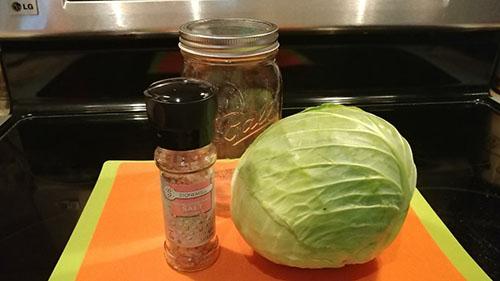
The recipe I’m sharing calls for Himalayan salt. But, you can use whatever salt you prefer. Years ago, Pink Himalayan salt wasn’t trending. So, you would have had to travel to the caves to find it. Fortunately, most grocery stores carry it now, making it easy to find. I opted to use it, because it’s thought of as a cleaner salt. Also, many claim that it’s healthier for the digestive system due to its mineral-rich traits.
Related: How to Make All-Natural Homemade Turmeric Pain Pills
The Benefits of Fermented Foods
The use of probiotics is on the rise. You don’t have to search in health food stores for supplements anymore. They are everywhere. However, they are quite expensive! So, many people are sticking with, or turning to fermented foods.
Fermented foods are created through a process of lacto-fermentation. This is when the natural bacteria feeds on the starch and sugar of the food that is creating the lactic acid. And here is why these foods are so healthy and beneficial to us:
- Preserve and create B-vitamins, beneficial enzymes, Omega-3 fatty acids, and a variety of probiotics
- Vitamin K2 (found in some fermented foods) aids in preventing plaque buildup in the arteries
- Boost the immune system and improve digestive health
- Detoxify the body by drawing out some heavy metals and toxins.
Along with the above benefits, it’s also far less expensive than probiotic supplements and more proficient, especially if you make your own.
So, why not make your own probiotic with an easy batch of homemade sauerkraut?
Making Sauerkraut For An Effective Probiotic
This recipe is really easy and I believe everyone should give it a try. These are the steps that need to be followed:
#1. Slice the cabbage into about 8 sections, discarding the core.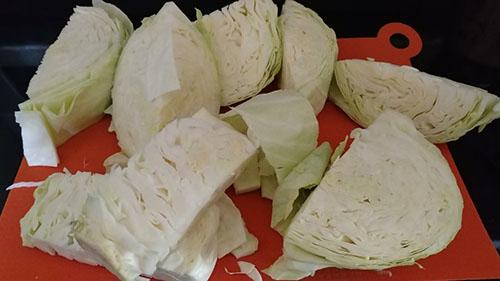
#2. Either shred the cabbage with a food processor or grater, or cut into thin ribbons with a knife.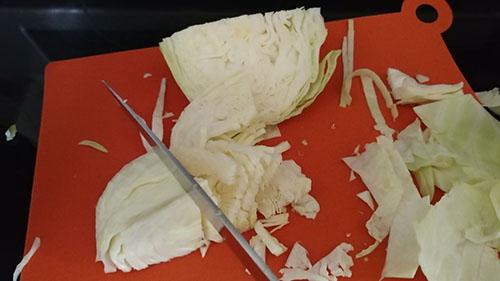
#3. Place the shredded cabbage into a large mixing bowl, and sprinkle salt over the top.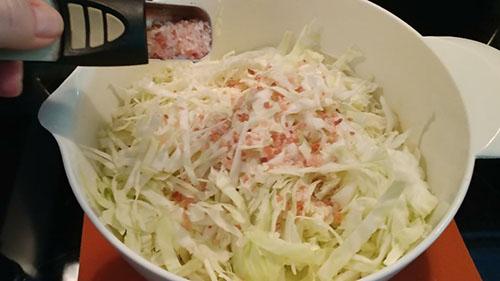
#4. Start kneading the salt into the cabbage by squeezing and mixing with your hands. If it’s not beginning to wilt or generate water, add more salt. Do this for approximately 4 minutes, then let it sit for another 10 minutes. Now is the time to add other seasonings if you want, such as black pepper, caraway seeds, or garlic.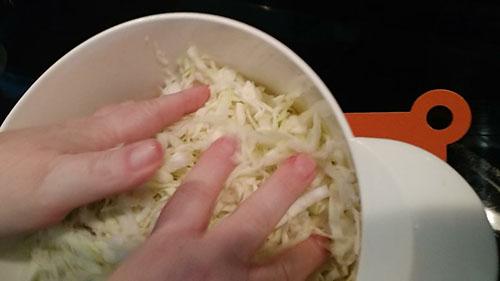
#5. Start packing the wilted cabbage into a canning jar. I used a small cabbage, and a quart jar was a perfect fit. Push the cabbage down with a spoon as you go along. Pour any leftover water from the bowl into the jar. Make sure the cabbage is submerged in liquid. If it’s not, add a little salt water to make sure the liquid is covering the cabbage.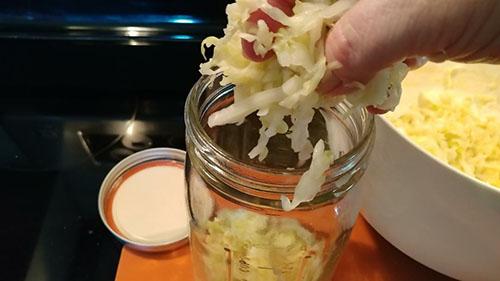
#6. Place the lid on the jar and let it sit in a room where the temperature is between 65°and 75° F.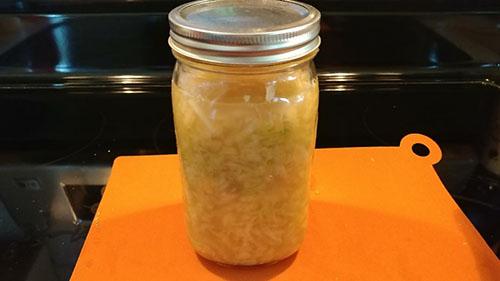
Over the next 24 hours, open the jar and press the cabbage down occasionally, and add extra liquid if necessary. The fermentation process should take about 10-14 days, but check on it daily to make sure the cabbage is fully submerged. You may notice some foam or bubbles during this time, but that is normal. And a good sign that it’s working. But, if you see mold, make sure to take it out and discard it.
Related: What Really Happens When You Only Eat Walmart Cans For 30 Days?
Start tasting it after 10 days. When it tastes good to you, place it in the refrigerator. It should last for about 6 months when refrigerated.
If you don’t eat too many fermented foods, then start adding this to your diet slowly. Start with a tablespoon of fermented foods a day, and gradually increase it until you are up to ¼ to ½ cup a day. Perhaps you don’t want to eat sauerkraut every day. No problem. Just mix it up with other fermented vegetables on the days you want a break from sauerkraut.
You may also like:
 How To Tell If Your Frozen Food Has Gone Bad
How To Tell If Your Frozen Food Has Gone Bad
The Pocket Soup that Saved the Lewis and Clark Expedition (Video)
18 Reasons to Stock Diatomaceous Earth for Survival

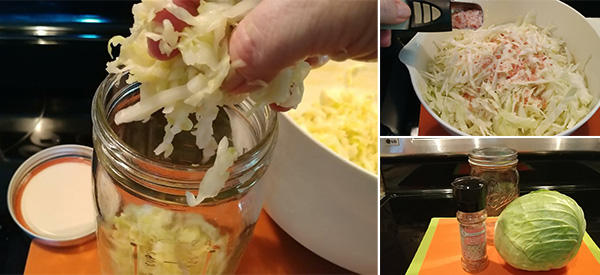













Sauerkraut also provides Vitamin C which is absolutely necessary to prevent scurvy, a miserable disease which leads to death. Scurvy and other vitamin deficiency conditions will be of prime concern to preppers in an EOTW situation.
There is a manual kitchen tool called a cabbage board. It is basically a really big wooden mandolin with three sharp blades. It is easy to use and makes short work of cabbage! It can be placed right over your fermenting crock so the shreds fall right in! Had to buy a new one recently, (Weston Brand, From Fante’s Kitchen Store in Phillie, PA) as my great great great grandmothers brought here from Germany finally needed to be retired!
I love getting this link!
I use a crock to put my sauerkraut in, I use 1/4 cup of salt to every 5 lb. I knead it till it’s juicy n add it to the batch before for the desired amount. I made 140 lb last year and got 60 quart bags to put in the freezer. Best you will ever taste! My Mom and Grammy’s recipe. In the crock for 18 days.
You added the new cabbage to an older batch?
Hello,
So you age your sauerkraut in a big crock, then put it into bags?? Then freeze? The freezing process does not hurt the probiotics?
Toby, not aging the ‘kraut. There are slow methods (winter ‘kraut) and fast (summer). Both do the same thing, but winter kraut needs a lot of salt to stave off molds when fermenting. You cannot age ‘kraut because the bacteria turn it to mush. The colder the weather, the slower it works so you can ‘keep’ it longer if you don’t freeze it. To us, summer ‘kraut is a lot better than winter ‘kraut. Freezing the ‘kraut won’t hurt the bacteria.We have a pot on now of summer ‘kraut. The dachshund is ‘guarding’ the stove. 🙂 niio
Hi, would you share your exact recipe with me? Would love to make a large batch and freeze. Thanks so much!
Ps this is my first time making sourkraut.
Wow, and I’d been making it since I was old enough to tamp it in the barrels and not fall in–too many times, anyway. We won’t go into how many decades that was… 🙂
Winter ‘kraut is shredded or chopped coarse cabbage (chopped it called russian style), with 9 level teaspoons of salt per gallon (6-8 lbs) shredded cabbage. Pack it in jars and keep topped with water. distilled, if you have a lot of mineral, like sulfur or copper. Winter kraut will develop a strong, unpleasant odor and has to be checked daily for mold growth. Keep the cabbage submerged! A plate with no exposed ceramics is best. A clean stone on that to weigh it down. We used old towels over the cabbage, and then the plate.
Summer ‘kraut is easier. It was made by native Americans and colonists who couldn’t afford salt, or shouldn’t have a lot. Shred and pack it in a good crock or jars, weigh it down, and keep covered with water. If using a cap, as well, do not tighten too much, just enough to hold on the lid or it might crack the jar. It the temps are 80-85 F. it should be done in 3 days or so. It it starts to get mold (a yeast), it’s done. It will not develop a smell, so after 3 days, taste the water before adding more. If it’s sour enough, then freeze it. There are folks who will let it go till it’s acid enough to, you’d swear, eat the enamel off your teeth.
Pack a few quart jars to experiment first. Keep a bowl under the jars because cabbage has natural sugar and when it ferments, it’s going to boil over. Throw that water away, tho if you’ve ulcers, it’s good to combat them. Because we live in a subtropical zone, gnats and other bugs are pests. They’ll lay eggs in the overflow.
You choose what style ‘kraut you like best before investing in a crock. We have a 10 gallon, but cabbage here is expensive, and there are no pick-your-own that don’t charge store prices, anyway. A few heads at a time, because the freezer only holds so much.
If you plan to preserve raw meat under fermented kraut, you’re best bet is winter kraut with the salt. Warning: Salt slows decay, not halts it, and doesn’t kill parasites found in meat. The kraut would have to be cooked, not eaten raw. niio!
I have problems with my stomach and digestive system so my question is does eating a spoonful of this a day help with digestion and weight loss?
A crock is what Koreans make their kimchi (another cabbage based, gut beneficial food) in, then bury the pot in the ground. However, there’s more to the recipe than cabbage and salt. So good!
HI
A recipe that makes a larger quantity made in crocks, wine pails with air locks, etc, and then put in jars and canned would be nice to see. Add a bit about red cabbage and green cabbage and if they should be made separately. Canning keeps them much longer than in refrigerator only. Joe
Joe
Joe, while you could can the sauerkraut, doing so ‘kills’ the probiotic qualities of the ferment, thereby defeating the purpose of fermenting. I beilieve there might be easier methods if all you want is canned kraut.
Joe, while you ‘could’ can the sauerkraut, the canning process would ‘kill’ the probiotics, negating the added benefits of fermentation. There are likely quicker and easier recipes for cannin kraut.
Canning sauerkraut will kill the enzymes. You want the raw fermented product to aid in gut health.
Making ‘kraut is easy enough, we never can it. Freeze it, yep, but I had it dried, as well (I live in Arizona). No salt is added, just distilled water. It’s called summer ‘kraut. niio
We couldn’t raise cabbage organicly due to the cabbage loopers feasting on our cabbage babies. We tried every thing for years and came up with a GREAT solution.
Grow red top turnups, easy to do, clean them, shred them, salt them and pack in a crock just like cabbage sauerkraut. You get all the probiotic benefits when used fresh. Enjoy and can for winter use.
Bugs hate agricultural lime. A thin dust of lime or wood ashes over cabbage knocked them off. redo after every rain. We used to grow cabbage by the acre and huckster it by the pickup load in an area everybody raised cabbage, and we always sold out. Back then, DDT was legal, but it was a waste because everything was getting immune to it.. Here, where I live now, it’s grasshoppers. They even gnaw scars in squash. Lime stops them, as well.
There is a Bt strain that only targets worms and works well on cabbage loopers. It is sold by Gardens Alive called “Green Step” and pretty sure it’s considered organic. There are also other brands.
This is a stupid question, but here it is. Can store bought
sauerkraut be used ?
Store bought sauerkraut is pasteurized thus killing off all the good things that were originally in the sauerkraut. Enzymes , probiotics ,etc
Look in the refrigerated sections of your local grocery store – fresh kraut will be in small jars or bags. I can find this at Safeway, as well as other local grocers. Whole Foods has it if you live near there.
Lea: Canned and most bagged the probiotics are dead. The medicinal value is still there, cabbage is good for that.
Summer kraut was developed when salt was too expensive to buy (at one time, a few pounds cost close to a day’s wages because it was all hand labor to make it, from cutting firewood, to boiling off sea water–if you lived near a salt spring or the sea). this is how eastern Native Americans still make it. We have an issue with salt. Right now, there are 3 quarts perking on the counter in bowls.
Recipe:
2 heads cabbage, shredded (if you aren’t a kraut fanatic you probably don’t have a kraut cutter, use the potato slicer on a food processor).
Pot or roasting pan.
Shred cabbage, put in pan and added
! level tablespoon of salt to help wilt it.
Let it sit covered overnight. The next day, pack into jars. Cover with distilled water (how we do it in Arizona,because copper and calcium in the water), place something in the jar to hold it under the water. I use lids from mayonnaise jars, which are the same size as canning rings, and can be used when you open a jar of home-canned. Put on jar lid, but do not tighten or you may crack the jar when the kraut ferments. keep warm at 80-85 F, and watch for mold–but it ferments so fast it’s rare there’s a problem. a week to 10 days, it’s done, not 3 weeks or more. The kraut should not smell bad, as cold fermenting does, and should be crunchy when you eat it. Raw, wow! With no salt, it’s fantastic.
this way, small batches, we have fresh kraut once a week. Extra, if any is left, can be frozen or dried to preserve the probiotics (our humidity levels can go as low as 4%). The funny thing is, this is considered a gourmet kraut now. niio (walk in beauty)
Where is your evidence proving that sauerkraut is the best Probiotic?
https://www.healthline.com/nutrition/11-super-healthy-probiotic-foods
Given, more and more people are coming up dairy intolerant. There’s a lot of gut problems dairy can cause, but not ‘kraut. ‘Kraut heals.
I’ve read about sauerkraut “juice”, the liquid, being studied in regards to healing stomach ulcers. Apparently about a tablespoon full a day helped to heal them.
Cabbage is also a good source of vitamin c, and sauerkraut was used by the German military to stave off scurvy, leading to the pejorative term “Krauts”. (Like the English being referred to as “limeys” – the British navy used limes to treat/prevent scurvy in sailors.)
I can’t find a link, to ask a general question. Many “back up” wild edibles contain calcium oxalate. These can crystalize in kidneys, causing severe damage. The usual recommendation is to throw out the water after cooking, along with any water soluable vitamin content, and to drink plenty of water to avoid kidney crystal formation. THE QUESTION: Would introducing vinegar, or some other houshold edible, chemically change the oxalate? If you don’t know, say so, or ask someone who does. Thank you.
Hi Steve – I guess the jury is out on whether or not ACV chemically changes (dissolves?) the oxalate – seems like links I find don’t want to definitively confirm yes on whether it does – maybe out of fear of being sued or something by the FDA?
I passed my first kidney stone almost a decade ago. An acquaintance had told me her husband also has a history of passing stones, so he tried drinking raw, organic, unfiltered ACV in response. It must’ve worked.
I tried it myself (4 teaspoons/20mL) in a 16 oz. water bottle, sweetened to taste with liquid stevia to make it drinkable, but only took it 1-2X/week. It wasn’t enough, as I passed my last stone about 4 years ago. Since then, I’ve been taking it at least 5 days/week, and haven’t had a problem since.
There’s some foods high in oxalate that I’m not willing to cut out of my life (except for nuts), so it’s much easier to take ACV daily.
My doctor told me that at any given time, I will always have several stones present in my kidneys – he showed me I had 7 in both kidneys when I saw him
The stones are tiny enough that they eventually pass without being noticed when I urinate, and its my belief ACV is responsible for keeping them small enough. And I do drink plenty of liquids as well.
Drinking lemon water should also accomplish the same thing.
I hope I answered the question – good luck.
I’ve read about sauerkraut “juice”, the liquid, being studied in regards to healing stomach ulcers. Apparently about a tablespoon full a day helped to heal them.
Cabbage is also a good source of vitamin c, and sauerkraut was used by the German military to stave off scurvy, leading to the pejorative term “Krauts”. (Like the English being referred to as “limeys” – the British navy used limes to treat/prevent scurvy in sailors.)
I read that cooking the greens crystallizes the oxalate. Eating pulses every day (peas, lentils, beans) puts a lot of soluble fiber in the urine, which helps prevent stones. Anything that acidifies the urine should break up stones, or at least erode them to the point they can be passed. I have one, thanks to two long trips across country and no exercise. Our water here and up there, Penna, is loaded with calcium and other minerals. I eat a lot of purslane in season, and Japanese knotweed when in Penna.Both are bad for oxalate acid. I also use a lot of cider vinegar and lemon juice, and that’s kept the stone from growing. No, it’s not a problem, it’s that small now. Usual method to stop them, acidify your diet by eating like the old-timers did, plenty of juice and exercise. People used to take a jug of water flavored with cider vinegar to work, to drink along with their cooked greens and ham fat. Jackie wrote an excellent post on stones.
You mention pulses. Is that a specific type of legumes?
https://pulses.org/nap/what-are-pulses/ The dry seeds of legumes.
I do not know the answer yo your question. What I do know is that my husband had kidney stones a number of years back. Very painful, had to go to the hospital. His doctor gave him a list of foods to avoid and foods to eat sparingly because they are high in oxalic acid. The list is not overly restrictive and he hasn’t had trouble since. Seems the easiest way to avoid problems.
I am glad to get this recipe. I just completed a 5 day fast per idmprogram.com to get my blood sugar under control, and I had an intense craving for fermented cabbage afterward, but didn’t know how to make it. I can’t find any in the store without sodium benzoate. I am making this tonight!
Look for Bubbies brand in the refrigerated case at health food store.
I love sauerkraut! (especially Bavarian style). Now I learn that canned ‘kraut from the grocery store is not good as a probiotic? Rats! I have no way of making it for myself due to a handicap. Is the Bubbies brand as good as homemade?
Don’t want to seem nosy, but why can’t you make ‘kraut? If you cut the cabbage small enough to put thru the potato slicer on a food processor, then pack in jars, you get ‘kraut. You can pack carrots, cucumbers and so on in the bottom to ferment, as well. If you don’t have a food processor, make Russian-style. They coarse cut the cabbage and pack it. ‘Kraut has a lot of lactic acid. The acid can eat metal from the cans. ‘Fresh’ ‘kraut from the stores has a lot of preservatives in it, as well. niio
I can’t speak for George, but my wife loved cooking and baking, and then had a massive stroke at work (she was a flight attendant and over the ocean at the time, so clot busters weren’t available)
When we finally got her out of the hospital and home, she discovered that almost all food preparation requires two hands, not one. My son and I do almost all of the cooking now.
There’s a brand in the stores called Cleveland kraut. Seen it in NY and FL. In the refrigerator section and veggie department. It’s fresh kraut with all the tasty probiotics. They have some variations too that are nice as well. Kraut and carrot, kraut and garlic, and red cabbage kraut with beets. You could easily lightly caramelized a chopped onion, along with a chopped apple, a little grated potato in a pan, add the plain fresh kraut and then a few caraway seeds if you like to make your Bavarian Kraut! ! I still have my great grandmothers crocks and cabbage board as a back up but sometimes you just need to take a short cut or two in the kitchen every now and then! This Cleveland Kraut is almost as good as hers! Appetite!
I love sauerkraut, never occurred to me it was so easy to make. One of my big disappointments in life was finding out that probiotics are a myth, one of the great examples of placebo effect. My Doctor is a real D.O. but her practice is completely alternative, built on acupuncture and Chinese herbal tradition. One fine day I punched my sparring partner in the knee with my face which led to dental work and a major course of antibiotics. I feared for the health of my intestinal biota and started taking probiotics, and bragged about it to my Doctor. She surprised me by pronouncing it a waste of time. Turns out the ecosystem of little critters in our intestines is so complex nobody knows what really goes on in there, and the only way anybody has found to restore that biota after it is damaged is by fecal transplant. No, I didn’t…
I eat a lot of ‘kraut. Where I was raised, it’s a sort of soul food and goes with pretty much every meal. What I can’t hack is salt, tho I live in Arizona. When I make ‘summer ‘kraut’, a half-gallon (or one gallon), use the family shredder (been in the family since someone made it over a century ago), and just pack it in the jars. Top with distilled water (ours has a lot of copper, which kills the bacteria). It should stay under 80 degrees to ferment right, to keep it crispy. If you can smell the stench, it’s not working right. Check it several times a day. No mold should form on it this way, but check it and top the water. What isn’t eaten raw or cooked freezes well and stays crispy. In Mexico, I had it dried and reconstituted. In Penna, Dominican neighbors would smell it cooking and come to the house. I gave away a lot and taught them how to make it. A sister-in-law in Ohio now makes summer ‘kraut, saying it’s the best she ever had.
Cabbage cores: Peel and ferment, if you like Japanese pickles. Better, eat raw and save a piece for my dachshund, who loves to eat them, especially if he can sneak them on the bed, under the covers where you find them when tired and worn out. Hey, at least he’s not a cat. they seem to like hiding them under the blankets just for you… niio
Gonna need to tap into that stockpiled TP
I prefer kimchi. I developed a love for it when I lived in South Korea.
I’m with you! I love kimchi…Do you have a good recipe to share?
joe
There are several Kimchi recipes on the web. Look them up.
Just one thing I would like to point out- salt is salt. Pink salt, himalayan salt, sea salt, table salt…. they are ALL approx 98% Sodium Chloride, so the differences are infinitesimal. I don’t care what the label says, or frankly what other people say- just because it claims to be more healthy or whatnot, DOESN’T change its chemical composition. Which is 98% Sodium Chloride. If you want a real healthy alternative- use Potassium Chloride. ZERO salt, but tastes the same and is high in Potassium.
It just drives me nuts when people think one salt is “more healthy” or “better” than another….
Then don’t use use it. I don’t, but I live in the desert and sodium is common in all water, even rain (from sodium in the dust the water droplet forms around). I like vinegar and other acidic things as flavoring. But, in the old days people used a pinch of wood ashes to give food a salty flavor–potassium and calcium. For preserving, we luck out. Low humidity makes drying a snap. For pickles, if the air is hot enough, no need for salt. Vegetables will ferment in water, no salt needed, if done right. Some people put a tablespoon of raw yogurt in each gallon of water used to ferment. I don’t because temps in the house are usually perfect for fermenting, between 75 and 85 degrees. niio